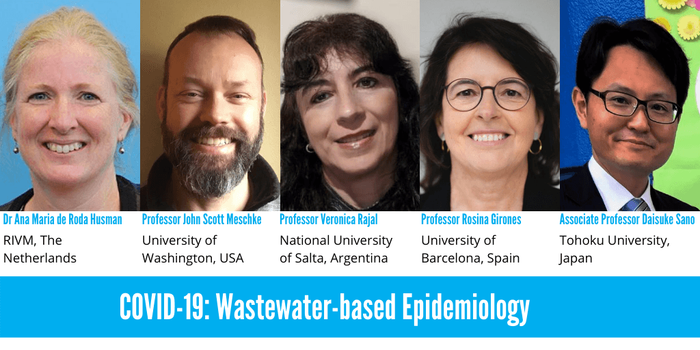IWA Webinar: COVID-19: Wastewater-based Epidemiology

Published on Jul 31, 2020
Long Term Experience and Health Significance of Virus Detection in Wastewater
Wastewater-based epidemiology (WBE) has recently gained global attention, since scientific reports indicate that the concentration of SARS-CoV-2 in wastewater is proportional to the number of COVID-19 patients in a sewershed. The study of viruses excreted in wastewater is not new and very valuable information has been obtained from other viruses in the past, analysing their molecular epidemiology and the geographical distribution. This experience can be reviewed as a reference for the analysis of the data that is being produced on SARS-CoV-2 in wastewater and for designing future strategies for the study of the epidemiology of COVID-19 and other viral infections.
This webinar has been organized by the IWA Specialist Group on Health-Related Water Microbiology (HRWM SG) and the IWA COVID-19 Task Force, the latter being set up in April 2020. During the webinar, specialist panelists provided updated information about WBE for SARS-CoV-2 and other important viral water pathogens, including poliovirus, adenovirus, hepatitis A and E and norovirus. This webinar had a global audience with an interest in learning about how to investigate viruses in wastewater and gain epidemiology-related data from wastewater and environmental water monitoring.
The panelists presented and discussed with the audience the potential of wastewater-based epidemiology (WBE) as an early warning system for public health. The webinar was moderated by Prof. Rosina Girones from the University of Barcelona in Spain and in the discussion also collaborated with Ricardo Santos from Instituto Superior Técnico in Portugal. The panelists included: Prof. John Scott Meschke from the University of Washington, USA; Dr. Ana Maria de Roda Husman who works at RIVM in The Netherlands; Prof. Verónica Rajal from the University of Salta but who is also a researcher at CONICET in Argentina and Assoc. Prof. Daisuke Sano from Tohoku University in Japan.
Opening the session, Prof. John Scott Meschke discussed the lessons learnt from the surveillance of poliovirus in wastewater and how these can be applied to monitoring SARS-Cov-2. He explained the following:
- The evidence from the environmental surveillance (ES) of poliovirus suggests that ES allows the introduction and circulation of the virus in a population to be recognised even when no clinical cases have been observed.
- Viral elimination from a population can be tracked and trends in viral transmission within a population can also be recognised.
- Data from a comparison of environmental surveillance methods adapted for SARS-CoV-2 suggests that multiple methods can return similar results on presence of SARS-CoV-2.
- The recoveries of methods are generally low, however they are fairly consistent although it was highlighted that further optimisation of methods is needed.
- The manner of reporting results and metadata must be harmonized to provide utility to public health efforts.
Dr. Ana Maria de Roda Husman further discussed environmental surveillance of SARS-Cov-2 in wastewater and offered insights where this has been carried out in The Netherlands. She highlighted the following:
- That testing sewage means you actually test not just one person but thousands of infected persons at the same time making it both cost-effective and non-invasive.
- Sewage surveillance should be complementary to COVID-19 and SARS-CoV-2 in people yielding other information e.g. for contact tracing or need for hospitalization.
- Wastewater surveillance can show trends in the spread of viruses over time within the localized population from not only symptomatics but also asymptomatics, presymptomatics and postsymptomatics.
- In countries with limited resources this approach may aid policy making, especially if performed for multiple pathogens such as poliovirus for which it is already globally used (WHO Global Polio Eradication Initiative) and for antimicrobial resistance in One Heath context (WHO Tricycle project).
Prof. Verónica Rajal presented on the presence of viruses as contaminants in river water and how this is impacted by wastewater. Specifically, she discussed the following:
- How the presence and/or quantification of viruses in water reflect the circulation of viruses in the population and can be used for different studies including but not limited to: the evolution, seasonality and spatio-temporal diffusion processes, the evaluation of circulation since vaccination or towards eradication and the persistence in the environment.
- When applying this approach certain methodological issues must be considered: the evaluation of the recovery of sample concentration and nucleic acid extraction; the determination of the sample limit of detection and the assessment of inhibition.
- In light of this wastewater surveillance of SARS-CoV-2 can be used for population-based health management
Assoc. Prof. Daisuke Sano described the experience in environmental surveillance systems for norovirus and alert systems based on norovirus concentration in wastewater and highlighted that there are at least three challenges that can be overcome by wastewater-based epidemiology of SARS-CoV-2 with these being the early warning of epidemics, the infection number projection, and the declaration of the epidemics end.
In summary, methods for the environmental monitoring or viruses are available and although there is still the need of optimization of methods for SARS-CoV-2, simple and low-cost protocols have been described that are also applicable in low-income countries. Research is going on to use wastewater-based epidemiology of SARS-CoV-2 for the infection number projection, however still more research is needed, and the application should be probably site-specific.
